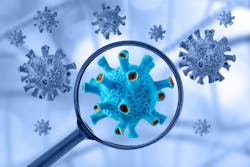An interdisciplinary team of scientists has made a breakthrough to understand how the body adapts to COVID-19 infection, potentially offering crucial insights into managing the complex disease.
Led by Christopher Wilson, professor of medicine at Loma Linda University, the collaborative effort involved researchers from Case Western Reserve University (CWRU) and the New Jersey Institute of Technology.
One puzzling phenomenon observed during the pandemic is the occurrence of “silent hypoxemia,” in which COVID-19 patients have dangerously low oxygen levels in their bloodstream without experiencing the typical symptoms of oxygen deprivation. This paradoxical effect, also known as "happy hypoxia," prompted researchers to investigate further.
By leveraging a mathematical model of breathing dynamics, developed in collaboration with Peter Thomas, professor of mathematics in CWRU’s College of Arts and Sciences, researchers simulated the conditions leading to silent hypoxemia.
Their findings, published in the journal Biological Cybernetics, suggest a potential link between elevated levels of hemoglobin in the bloodstream and the body's response to COVID-19 infection.
The key research finding in the model was that one could produce sustained hypoxia without otherwise compromising breathing by increasing the parameter representing the hematocrit—the concentration of hemoglobin in the bloodstream.
Hemoglobin is a special molecule that helps red blood cells carry oxygen from the lungs to the rest of the body. In communities living at high altitudes—such as the Tibetan Plateau or the Andes Mountains—many people have higher-than-average hemoglobin levels in their blood.
Although COVID-19 can affect many parts of the body, it mainly attacks the respiratory system, making it difficult to breathe and causing blood clots in the lung.
“In our research endeavors, we've unearthed a pivotal insight: the imperative for critical care physicians to vigilantly track hemoglobin levels in COVID-19 patients,” Thomas said.

